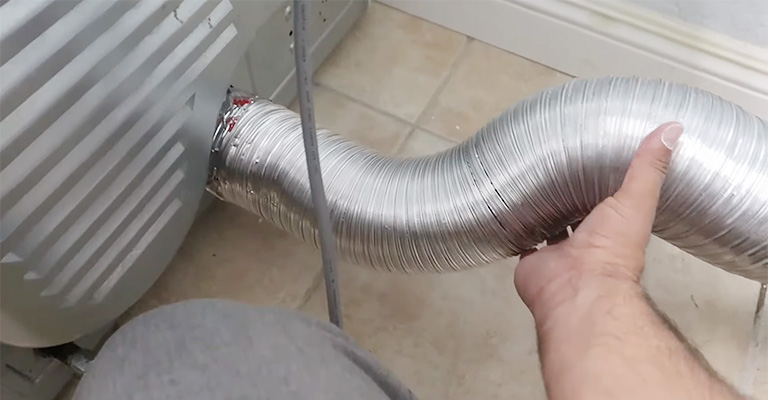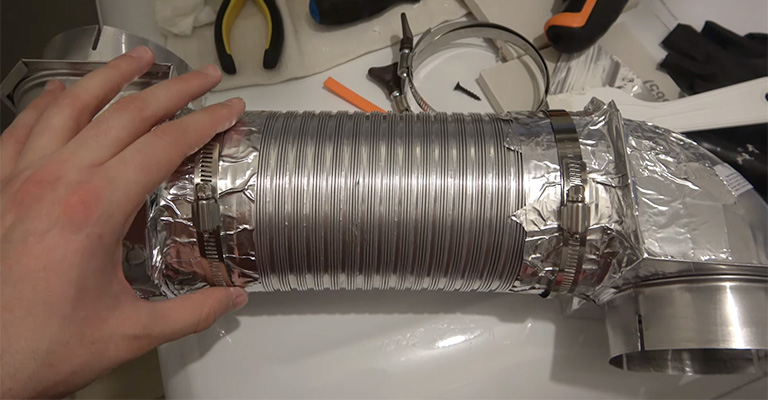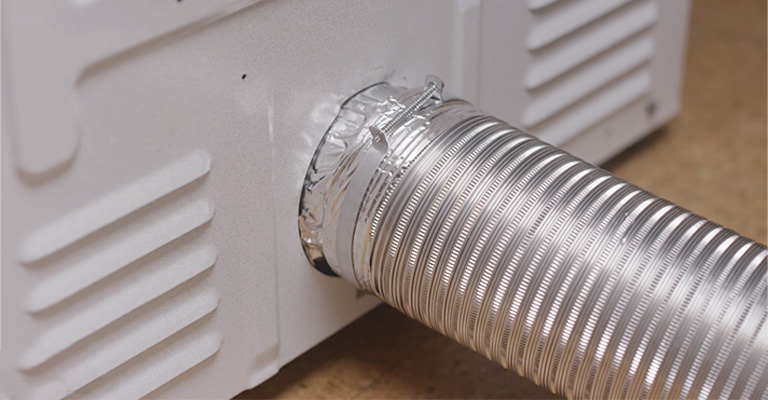Duct tape is often a versatile and readily available solution for household repairs and quick fixes.
However, when dealing with essential home appliances like dryer vents, it’s essential to consider safety, durability, and long-term effectiveness.
Many wonder whether duct tape is suitable for sealing or repairing a dryer vent. To begin with, don’t use duct tape, as the adhesive will fail at extreme temperatures.
You should also avoid using duct tape on your air ducts. When used on dryer vents, duct tape seriously threatens your home’s safety and health.
What Type Of Tape Do I Use On A Dryer Vent?
Foil-backed tape is recommended for sealing seams on dryer vents and HVAC ducts. On the other hand, using duct tape is not a good idea since the adhesive fails under extremely cold conditions.
As dryer vents can experience high temperatures during use, foil tape should be used to seal them. With this tape, you are assured that it will be airtight and able to handle temperature swings that would be too great for other types of tape.
The extreme heat can cause other tapes to fail, even duct tape. There is also the risk of fire when using non-foil tape.
The Problems With Duct Tape

Using duct tape on your dryer vent or even air ducts can cause several problems. There are two main parts of the duct tape: its adhesive and its backing.
As far as duct tape is concerned, it will never last forever. As the temperature fluctuates, the adhesive on the tape will dry out when used on dryer vents.
It does not take long for the tape to dry and fall off. Your home is at risk of a fire resulting from hot hair billowing out of the duct.
A further danger is that the tape can catch fire if it heats up enough. A house fire can easily be started by dried tape, known as tinder.
Using duct tape on your dryer vents or air ducts can also be problematic since you cannot access your vents.
Modern homes’ walls, ceilings, and floors are surrounded by wall-and-ceiling appliances and ducts that are difficult to reach or clean.
Although you may have difficulty reaching the ductwork to patch a hole, it is still possible. If you need any repairs done to your air ducts, seek the help of a professional company.
Finally, gas appliances cause the most problems. Carbon monoxide can be produced when clothes dryers are powered by gas. In addition to being colourless, odorless, and toxic, this gas is also highly flammable.
Whenever the vent transports this unsafe gas from your home, rips, tears, or cracks in the ductwork may allow it into your home. The best way to seal these ducts isn’t with duct tape, which fades and becomes brittle over time.
How Do You Seal A Dryer Vent?

If you want to seal your ducts, use foil tape instead of duct tape. There is a much higher degree of durability with foil tape than metal tape. Furthermore, it is crack-resistant and will resist heat and fire.
The ability to operate gas appliances safely is a crucial quality. You can find a wide variety of foil tapes in your local hardware store.
Dryer Vent Don’ts
According to the mistakes we’ve seen a lot of homeowners make with dryer vents, here are some things to avoid.
1. Pay attention to signs that your clothes dryer seems to be malfunctioning.
You should look out for warning signs that your dryer vent is blocked or clogged, as this could pose a fire hazard.
2. You cannot prevent pests from entering your home by using cages or screens.
Using pest cages or screens, lint can build up, creating a fire hazard and reducing the dryer’s effectiveness.
3. Ensure dryer vents are not terminated in crawl spaces or attics.
Dryer vents positioned in crawl spaces or attics create a breeding ground for mold. These vents can cause health problems by allowing moisture to accumulate and deposit. An exhaust vent for a dryer must be located outside the building.
4. Secure joints with tape, not screws or bolts.
Within the vent wall, screws and bolts act as lint collectors and increase fire hazards.
5. Plastic and PVC pipes should not be used for dryer vents.
Static in plastic and PVC venting causes lint to stick to its interior walls, which can combine with the expelled water during a typical dry cycle, causing sludge, clogs, and increased fire risks.
A cool, smooth surface of PVC sweats when moist, warm air passes through it. This creates lint, which becomes hard to clean.
It takes longer for PVC to heat up, allowing the water inside the pipe to remain in vapor form. It is the water and lint that cause sludge to build up in the vent, as well as the accumulation of lint.
6. Use none of the vinyl or foil materials that look like slinky foil for dryer vents.
A flexible or foil vent can easily be bent or crushed, restricting airflow.
Similarly, vinyl and slinky materials contain ridges that catch excess lint, increasing the fire risk. As a result, if a dryer fire occurs, these materials will quickly spread it.
Final Words
The ducts, vents, and heating or cooling ducts you seal should be sealed with heat-resistant tapes, such as aluminum foil tape. The dryer duct and vent system will remain secure since foil tape will not dry out after installation.







